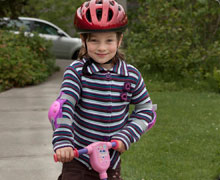Skateboard, Scooter and Skating Safety
You can download this article as a PDF (English, Spanish).
Skateboard, Scooter and Skating Safety

Skateboards, scooters and skates provide fun ways for your child or teen to get the 60 minutes of physical activity that they need each day. Teach beginners to start out slow on flat surfaces. Take the time to teach your child how to stop, balance, control speed and turn. Schoolyards, parks and empty parking lots can be good places to learn and practice.
Skateboarding
- Wear a properly fitting multi-impact helmet for every ride. Make sure it’s buckled! Helmets used for riding a skateboard should meet the ASTM F1492 skateboard helmet standard. Check the inside of the helmet for a sticker that says “ASTM F1492.”
- Wear wrist guards, elbow pads, knee pads and sturdy, closed-toe shoes. Add gloves and padded skateboard clothing for extra protection.
- Skateboards with short decks and wide wheels are best for beginners.
- Check your child’s board before each use to be sure it is in good condition.
- Ride on smooth pavement. Watch for holes, bumps, rocks and other debris to avoid.
- Watch for hazards such as people getting in or out of parked cars, drivers pulling out from driveways and all types of traffic, like bikers, walkers and animals.
- Tell your child how to fall more safely. If they are losing their balance, crouch down so there is not as far to fall, try to relax the body and roll onto fleshy parts, rather than absorbing the fall with arms.
- Skate during the day
- Never skateboard in traffic and never hold onto moving vehicles while skateboarding.
- Get off the skateboard and walk across crosswalks, obeying traffic signals and signs and looking both ways.
- Children under 5 should not skateboard.
- Supervise your 6- to 10-year-old while they are skateboarding.
Scooter riding
- Wear a properly fitting helmet for every ride. Make sure it’s buckled! Choose a helmet that meets safety standards. Look for a CPSC (U.S. Consumer Product Safety Commission) or Snell sticker inside the helmet.
- Wear knee pads, elbow pads and sturdy, closed-toe shoes.
- Check your child’s scooter brakes and other parts before each ride.
- Ride on smooth pavement and avoid wet surfaces. Watch for holes, bumps, rocks and other debris to avoid.
- Watch for hazards such as people getting in or out of parked cars, drivers pulling out from driveways and all types of traffic, like bikers, walkers and animals.
- Keep weight evenly distributed and face the handlebars when riding.
- Avoid “t-hugger” riding, where the rider hugs the handle with the body and feet.
- Ride during the day.
- Do not ride in traffic and never hold onto moving vehicles while riding.
- Get off the scooter and walk across crosswalks, obeying traffic signals and signs and looking both ways.
- Only allow one person on the scooter at a time.
- Watch children under 8 very closely.
Rollerblading, inline skating and rollerskating
- Wear a properly fitting helmet for every ride. Make sure it’s buckled! Choose a helmet that meets safety standards. Look for a CPSC (U.S.Consumer Product Safety Commission) or Snell sticker inside the helmet. For trick or aggressive skating, use a multi-impact helmet that meets the ASTM F1492 standard.
- Wear wrist guards, elbow pads and knee pads.
- Check your child’s skates before each use to be sure they are in good condition.
- Skate on smooth pavement. Watch for holes, bumps, rocks and other debris to avoid.
- If your child is a beginner, have them practice balancing. Have your child stand with their feet about six inches apart with their knees slightly bent. Have them put their weight on the balls of their feet rather than placing their weight over the heels.
- Watch for hazards such as people getting in or out of parked cars, drivers pulling out from driveways and all types of traffic, like bikers, walkers and animals.
- Tell your child to come to a complete stop at curbs, check the traffic signal or sign, look both ways for traffic and then sidestep up or down.
- Skate during the day.
- Do not skate in traffic and never hold onto moving vehicles while skating.
- By the age of 4, children often have the balance to use four-wheeled non-inline skates. By age 6, most kids have the balance needed to stand using inline skates.
To Learn More
Read Bike and Multi-Sport Helmets: Quick Fit Check (PDF) to learn more about helmets.
30-second version
